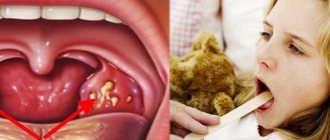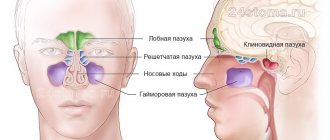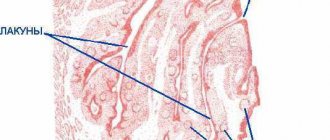What is angioedema of the larynx? Most likely, most respondents not related to medicine will not be able to answer this question. But if you voice another name for this condition - Quincke's edema - everything will fall into place.
Angioedema of the larynx is an acute, rapidly developing edema of the deep layers of the skin, subcutaneous tissue and mucous membrane. Angioedema of the larynx is very dangerous, because in the absence of emergency help, the airways can completely block, leading to asphyxia and death.
Angioedema of the larynx is an aggressive reaction of the body to external stimuli. When interacting with an external factor, the body releases biologically active substances into the blood as protective measures - histamine, bradykinin, etc. This whole process occurs with the expansion of blood vessels and an increase in their permeability. Ultimately, the lymph from the capillaries leaks into nearby tissues, causing severe swelling. The mechanism of angioedema formation is similar to the appearance of allergic urticaria. Only in the latter case, the vessels dilate in the upper layers of the skin, so urticaria is not dangerous, but in case of angioedema of the larynx - in the deep layers of the skin.
This is a relatively new medical condition. It was first described in his works at the end of the 19th century by the German physician Heinrich Quincke. Swelling of the throat develops very quickly - several hours or even minutes can pass from the moment of interaction with the irritant. Therefore, treatment and assistance for swelling of the throat should be urgent.
Swelling of the throat - what is it?
People of all ages can experience an extremely dangerous condition, symptomatically described as swelling of the throat. This secondary pathology (not an independent disease) is expressed in a narrowing of the lumen of the larynx and indicates the development of diseases of various origins or injury to the organ. Swelling of the throat, the causes of which are inflammatory or non-inflammatory in nature, according to the nature of the course can be:
- lightning - manifests itself in cases of injury to nearby tissues or allergies; the clinical picture is formed within a few minutes;
- acute - accompanies inflammatory processes and infectious diseases; temporary establishment of a full-scale clinic takes up to several hours;
- chronic - detected in the event of neoplasms (benign or malignant); Full development of clinical manifestations requires from several days to several weeks.
1.General information
Laryngeal edema is a life-threatening condition that manifests itself as obstruction of the upper respiratory tract and, in the case of severe asphyxia, can be fatal.
Like other local edema, laryngeal edema is an accumulation of fluid in the intercellular space, as a result of which the tissue swells and increases in size, and the air lumen, accordingly, narrows. In contrast to the spasm of the larynx described on our website (see), which in most cases resolves quite quickly, swelling of the larynx can persist for a long time; any tendency towards its progression requires emergency medical attention.
Obviously, local laryngeal edema cannot be considered an independent disease - it is always a consequence of some process, reaction or condition. In general, there are many reasons, which explains the relatively high incidence of laryngeal edema in clinical practice.
A must read! Help with treatment and hospitalization!
Swelling of the throat with sore throat
International medical practice classifies inflammation of the tonsils as acute tonsillitis. However, the more familiar name for us “angina” (translated from Latin means “squeeze, strangle”), quite accurately describes the ongoing pathological process. Swelling of the throat during sore throat partially blocks the airways, and the patient begins to choke. This rather serious local complication is accompanied by:
- stridor (difficulty noisy breathing);
- pain when swallowing in the absence of cough;
- swelling of the neck, change in color of the skin of the face (pallor, and then cyanosis).
Types of edema.
There are several types of Quincke's edema.
Angioedema can be hereditary or acquired. Hereditary angioedema is a rare genetic disease that was first described at the end of the 19th century and is characterized by recurrent edema. If a mother or father has this diagnosis, the probability that their child will be born with the same diagnosis is 50%. With timely prevention and proper treatment, the patient’s attacks rarely occur, and the patient lives quite well with this diagnosis. Cases of acquired disease are quite small, and are most often observed in elderly patients.
Depending on the cause that caused Quincke's edema, allergic, non-allergic and idiopathic edema are distinguished when the cause of the condition could not be determined.
Swelling of the throat due to a cold
One of the symptoms accompanying colds is swelling of the larynx. Swelling of the throat during a cold manifests itself:
- sore throat, pain when swallowing;
- dry cough, change in voice timbre up to aphonia (complete loss of voice);
- difficulty breathing.
The severity of the clinical picture depends on the disease and the individual reactivity of the patient’s body. For example, with false croup, swelling of the throat in a child can be complicated by laryngeal stenosis.
croup
“Croup”, “acute or recurrent laryngitis/laryngotracheitis”, “acute airway obstruction”, “larynx stenosis” - are the names listed above synonymous or are they independent nosological forms? Every practicing physician should have a clear understanding of what the listed terms mean.
Probably the most widely used term, especially in pediatric practice, is “croup,” and the most general term can be considered “acute airway obstruction,” but in ICD-10 the codes are given according to the “organ principle.”
So, croup (from the Scottish croup - to croak) is an infectious disease syndrome that always implies the presence of acute stenosing laryngitis (or laryngotracheitis, or less commonly laryngotracheobronchitis), accompanied by hoarseness, a “barking” cough and shortness of breath, often of an inspiratory nature. That is, croup is understood as the presence of a certain syndrome with a triad of clinical symptoms: stridor—barking cough—hoarseness. The syndrome is formed in diseases manifested by the development of an acute inflammatory process in the mucous membrane of the larynx and trachea. Therefore, the term “croup” is applicable only to infectious diseases! Domestic pediatricians traditionally divide croup into “true” and “false”, depending on the level of damage to the larynx, although this division is extremely arbitrary, since the mucous membrane of the larynx along its entire length, as well as the mucous membrane of the underlying parts of the respiratory tract, is often involved in the process. “True” croup develops as a result of damage to the true vocal cords (folds). The only example of “true” croup is diphtheria croup, which occurs with the formation of specific fibrinous changes on the mucous membrane of the vocal cords. “False” croup includes all stenotic laryngitis of a non-diphtheria nature, in which the inflammatory process is localized mainly on the mucous membrane of the subglottic (subglottic) zone of the larynx. “Acute laryngitis” is coded J04.0 in ICD-10, “acute laryngotracheitis” is J04.2, “acute obstructive laryngitis” is J05, and “chronic laryngitis” and “chronic laryngotracheitis” are J37.0 and J37.1, respectively. . In any case, it should be understood that acute obstruction of the upper respiratory tract (narrowing of the lumen of the larynx with breathing disorders and the development of acute respiratory failure) is primarily an emergency condition that requires emergency diagnosis and treatment at the prehospital stage.
This condition most often occurs in children of early and preschool age (from 6 months to 3 years, and in 34% of cases - in children of the first 2 years). Acute obstruction is associated with the anatomical and physiological characteristics of the respiratory tract in young children: the narrowness of the lumen of the trachea and bronchi (funnel-shaped instead of cylindrical), the tendency of their mucous membrane and the loose fibrous connective tissue located underneath to develop edema, the peculiarities of the innervation of the larynx, which are associated with the occurrence of laryngospasm, and relative weakness of the respiratory muscles. Swelling of the mucous membrane with an increase in its thickness by only 1 mm reduces the lumen of the larynx by half! The development of acute obstruction of the upper respiratory tract in adults is a fairly rare phenomenon and is usually associated with diphtheria.
There are infectious and non-infectious causes of acute obstruction of the upper respiratory tract. Infectious causes include viral infections (caused in 75% of cases by influenza and parainfluenza viruses of type I, as well as rhinosyncytial viruses, adenoviruses, less commonly measles and herpes viruses) and bacterial infections (with the development of epiglottitis, retropharyngeal and peritonsillar abscess, diphtheria). In this case, the mechanism and routes of transmission of the pathogen are determined by the epidemiological features of the main infectious disease. Aspiration of foreign bodies, laryngeal injuries, allergic edema, laryngospasm can be non-infectious causes of the development of acute obstruction of the upper respiratory tract.
In the genesis of airway obstruction, three factors play a certain role: edema, reflex spasm of the laryngeal muscles and mechanical blockage of its lumen with inflammatory secretion (mucus) or a foreign body (including food, vomit, etc.). Depending on the etiology, the significance of these components may vary. In practical work, in order to conduct adequate therapy and provide effective assistance to a child, it is important to be able to quickly differentiate them.
The main reason for the development of croup is an inflammatory process in the area of the subglottic space and vocal cords (acute stenotic laryngotracheitis). The phenomenon of narrowing of the lumen of the upper respiratory tract during croup is formed sequentially, in stages, and is directly related to the reaction of the laryngeal tissue to an infectious agent, including one that triggers an allergic reaction. When assessing the clinical picture, it is necessary to take into account the prevalence of edema of the inflamed mucous membrane, spasm of the muscles of the larynx and trachea and hypersecretion of mucus, since this is fundamental when choosing treatment tactics.
Breathing disorders due to narrowing of the lumen of the larynx most often occur at night, during sleep, due to changes in the conditions of lymph and blood circulation of the larynx, a decrease in the activity of the drainage mechanisms of the respiratory tract, the frequency and depth of respiratory movements.
The clinical picture of acute stenosis of the upper respiratory tract is determined by the degree of narrowing of the larynx, associated disturbances in respiratory mechanics and the development of acute respiratory failure.
With incomplete obstruction of the larynx, noisy breathing occurs - stridor, caused by intense turbulent passage of air through the narrowed airways. With dynamic narrowing of the airway lumen, normally silent breathing becomes noisy (due to vibrations of the epiglottis, arytenoid cartilages, and partly the vocal cords). When swelling of the laryngeal tissues dominates, a whistling sound is observed; when hypersecretion increases, hoarse, bubbling, noisy breathing is observed; with a pronounced spastic component, the sound characteristics are unstable. It should be remembered that as stenosis increases due to a decrease in tidal volume, breathing becomes less and less noisy!
Inspiratory stridor usually occurs when there is narrowing (stenosis) of the larynx at or above the vocal cords and is characterized by noisy inspiration with retraction of the chest wall. Stenoses below the level of the true vocal cords are characterized by expiratory stridor with the participation of auxiliary and reserve respiratory muscles in breathing. Laryngeal stenosis in the subglottic space usually manifests as mixed inspiratory and expiratory stridor. The absence of voice changes indicates the localization of the pathological process above or below the vocal cords. The involvement of the latter in the process is accompanied by hoarseness or aphonia. A hoarse, “barking” cough is typical of subglottic laryngitis. Other signs of upper respiratory tract obstruction are nonspecific: anxiety, tachycardia, tachypnea, cyanosis, neurovegetative disorders, etc. Rapid breathing and elevated body temperature during croup can lead to significant fluid loss and the development of respiratory exicosis.
Based on the severity of narrowing of the lumen of the larynx, four degrees of stenosis are distinguished, which have significant differences in the clinical picture (see table). However, when making a diagnosis, the severity of the croup is determined primarily, and not the severity of the stenosis (the assessment of the latter is possible with direct laryngoscopy, which is impossible at the prehospital stage). In a comprehensive assessment of the patient’s condition, factors such as the participation of auxiliary muscles in the act of breathing (evidence of a significant narrowing of the airway lumen), symptoms of respiratory and cardiovascular failure, depression of consciousness and persistent hyperthermia should be taken into account.
Thus, the classification of croup is built taking into account:
- etiology of croup (viral or bacterial);
- stages of laryngeal stenosis (compensated, subcompensated, decompensated, terminal);
- nature of the course (uncomplicated or complicated - the appearance of a mixed infection due to the addition of a secondary bacterial purulent infection to the main process).
- with the development of diphtheria croup, the nature of the spread of the inflammatory process is also taken into account (spread to the mucous membrane of the trachea, bronchi and bronchioles is possible - the so-called descending croup).
- recurrence of the syndrome.
DIFFERENTIAL DIAGNOSIS
Diphtheria of the larynx
Diphtheria of the larynx is most often combined with manifestations of this infection in another location (diphtheria of the pharynx or nose), which greatly facilitates diagnosis. The main differences between diphtheria of the larynx and croup that developed against the background of acute respiratory viral infection are the gradual onset and severity of the course with increasing symptoms. The voice with diphtheria of the larynx is persistently hoarse with the gradual development of aphonia. In the treatment of diphtheria of the larynx, along with measures aimed at restoring airway patency, it is necessary to urgently administer anti-diphtheria serum to the child using the Bezredko method in a dose of 40-80 thousand IU per course of treatment, depending on the form of the disease.
Allergic swelling of the larynx
Allergic laryngeal edema is not always possible to distinguish from croup of an infectious nature only by clinical signs. Allergic laryngeal edema develops under the influence of any antigen of inhalation, food or other origin. There are no specific guidelines for ARVI. Fever and intoxication are not typical. These children have a history of various allergic sympathies: skin manifestations of allergies, food allergies, Quincke's edema, urticaria, etc. During therapy with inhaled glucocorticoids with the addition of b2-adrenomimetics (salbutamol - Ventolin), anticholinergics (ipratropium bromide - Atrovent ), combined drugs (a combination of fenoterol and ipratropium bromide - berodual), and also, according to indications, antihistamines, rapid positive dynamics of stenosis occurs.
Laryngospasm
Laryngospasm occurs mainly in children of the first 2 years of life against the background of increased neuromuscular excitability, with manifestations of current rickets with a tendency to tetany. Clinically, spasm of the larynx manifests itself unexpectedly; the child experiences difficulty breathing with a characteristic sound in the form of a “cock crow”, while fear, anxiety, and cyanosis are noted. Mild attacks of laryngospasm are relieved by spraying the child’s face and body with cold water. You should try to induce a gag reflex by pressing on the root of the tongue with a spatula or spoon, or provoke sneezing by irritating the mucous membrane of the nasal passages with a cotton swab. If there is no effect, diazepam should be administered intramuscularly.
Epiglottitis
Epiglottitis is an inflammation of the epiglottis and adjacent areas of the larynx and pharynx, most often caused by Haemophilus influenzae type b. The clinical picture is characterized by high fever, sore throat, dysphagia, muffled voice, stridor and respiratory failure of varying severity. Palpation of the larynx is painful. When examining the pharynx, a dark cherry color of the root of the tongue, its infiltration, swelling of the epiglottis and arytenoid cartilages that close the entrance to the larynx are revealed. The disease progresses rapidly and can lead to complete closure of the lumen of the larynx.
At the prehospital stage, it is optimal to inject a third-generation cephalosporin antibiotic (ceftriaxone) as early as possible. Transport of the child to the hospital is carried out only in a sitting position. You should avoid taking sedatives. You need to be prepared for tracheal intubation or tracheotomy.
Retropharyngeal abscess
Most often, retropharyngeal abscess occurs in children under three years of age. It usually develops against the background of or after an acute respiratory viral infection. The clinical picture is dominated by symptoms of intoxication, severe fever, sore throat, dysphagia, stridor, and drooling. There is no barking, rough cough or hoarseness. Coughing is difficult due to severe pain in the throat. The child often takes a forced position - with his head thrown back. Examination of the pharynx presents significant difficulties due to the child’s severe anxiety and inability to open his mouth. Sedation is used for examination.
Treatment is not carried out at the prehospital stage. Urgent hospitalization to the surgical department is required. In the hospital, the abscess is opened and drained while receiving antibiotic therapy.
Foreign bodies
Foreign bodies of the larynx and trachea are the most common cause of asphyxia in children. Unlike croup, aspiration occurs unexpectedly in the context of apparent health, usually while the child is eating or playing. A coughing attack appears, accompanied by suffocation. The clinical picture depends on the level of airway obstruction. The closer to the larynx the foreign body is located, the greater the likelihood of asphyxia. This location of the foreign body is usually accompanied by the appearance of laryngospasm. The child is scared and restless. During auscultation, you can sometimes hear a popping sound, indicating the release of a foreign body.
After examining the oral cavity and entering the larynx, attempts are made to remove the foreign body by mechanically “knocking out” it. A child under 1 year of age is placed face down with the head end down 60°. With the edge of the palm they give him short blows between the shoulder blades. In children older than one year, sharp pressure with the hand on the abdomen from the midline inward and upward (at an angle of 45°) can be effective. In older children, blows to the back are alternated with sharp compression of the abdomen, clasping the child with the arms from behind (Heimlich maneuver).
If attempts to remove a foreign body using mechanical techniques are ineffective, the issue of urgent intubation or tracheotomy should be addressed.
Treatment of croup
Treatment of croup should be aimed at restoring the patency of the larynx: reducing or eliminating spasm and swelling of the laryngeal mucosa, freeing the lumen of the larynx from pathological secretions.
- Patients are subject to hospitalization in a specialized or infectious diseases hospital if it has an intensive care unit, but treatment should begin at the pre-hospital stage.
- The child should not be left alone; he must be calmed down and picked up, since forced breathing during anxiety or crying increases the symptoms of stenosis and the feeling of fear.
- The room temperature should not exceed 18°C. Effective coughing up of sputum is also facilitated by the creation of an atmosphere of high humidity in the room where the child is located (the “tropical atmosphere” effect), steam inhalation (isotonic NaCl solution through a nebulizer). A warm drink is indicated (hot milk with soda or Borjomi).
- Etiotropic therapy is effective for diphtheria croup - administration of anti-diphtheria serum IM or IV.
- Antibiotics - for diphtheria croup and croup complicated by secondary bacterial infection.
- Expectorant and mucolytic drugs administered primarily by inhalation, for example ambroxol (lazolvan), etc., contribute to the dilution and removal of mucus from the respiratory tract.
- Considering the significant participation of the allergic component in the development of croup, it is advisable to include antihistamines (for example, chloropyramine (suprastin), etc.) in the complex of therapeutic measures. Randomized double placebo-controlled study Gwaltney JM et al. [3] showed that in the treatment of acute respiratory diseases, a combination of antipyretic, antihistamine and antiviral drugs can effectively (33-73% compared with placebo) reduce the severity of various clinical manifestations of the disease, including the amount of mucus produced and pain in the pharynx and larynx . In another work, the same authors [2] demonstrated that clemastine, prescribed in the complex treatment of ARI, in contrast to pheniramine, only increases the sensation of dryness and soreness in the throat. And Gaffey MJ et al. [1] noted no effect from the use of terfenadine in a similar clinical situation.
- Glucocorticoids, for example prednisolone at a dose of 3-10 mg/kg - to relieve swelling of the laryngeal mucosa.
- Psychosedatives - with severe spasm of the laryngeal muscles. For routine treatment of spastic symptoms, tranquilizers are used.
- Intubation and tracheostomy are indicated when conservative therapy is ineffective and during resuscitation measures (asphyxia, clinical death).
So, until recently, therapy for croup was limited mainly to the supply of humidified air and the administration of systemic steroids. However, given the fact that croup most often develops in infants and young children, in whom both oral and injected steroids pose a serious problem, and also that the entire medical community is currently striving to reduce the possible risk of side effects of systemic steroid therapy, the use of inhaled glucocorticoids seems especially promising. To date, vast experience has been accumulated in the treatment of stenosing laryngitis/laryngotracheitis with inhaled budesonide (Pulmicort) through a nebulizer. The effectiveness of this type of therapy was, in particular, discussed by Ausejo et al. a meta-analysis of 24 (!) randomized controlled trials, which also compared the effectiveness of inhaled budesonide and systemic dexamethasone. It was shown that the use of budesonide through a nebulizer for croup compared with dexamethasone by injection significantly reduced the number of cases when the use of adrenaline was considered necessary (by 9%), and also influenced the duration of emergency care both at the prehospital and in-hospital stages . Nebulized administration of budesonide was effective in children with both mild-moderate and moderate-severe croup. Moreover, inhaled single doses (2 or 4 mg) of budesonide were significantly more effective than placebo and were comparable in effectiveness to dexamethasone (0.6 mg/kg). They invariably led to the leveling of lobar symptoms and a decrease in the duration of hospital treatment.
In order to reduce swelling of the mucous membrane of the larynx, which often spreads to the trachea and bronchi, and relieve spasm, b-adrenomimetics can be used simultaneously with budesonide (salbutamol - Salgim, Ventolin, anticholinergics - ipratropium bromide (Atrovent), a combination of b-adrenergic agonists and anticholinergics - berodual).
It should be noted that acute stenosing laryngotracheitis occupies a significant place in the structure of emergency medical calls to children. So, in Moscow last year, parents contacted the ambulance about 198 thousand times. And if we discard cases of acute respiratory infections and influenza (approximately 70 thousand), acute surgical pathology and trauma (58 thousand) and a group of intestinal infections (12 thousand), then of the remaining calls, every ninth or tenth was precisely about the child’s difficulty breathing ( attack of bronchial croup). Moreover, if the frequency of calls for exacerbation of asthma has decreased over the past 3 years, then for croup, on the contrary, it has increased (by about 1000 cases).
In our department of hospital-replacement technologies of the Scientific Center for Children's Health of the Russian Academy of Medical Sciences, where emergency care for children is also provided, over the past 2.5 years (since September 2000), acute stenosing laryngotracheitis has been treated for 100 children (67 boys and 33 girls) aged 6 months up to 7 years. Acute obstruction of the upper respiratory tract developed in 32 children against the background of ARVI, in 5 - during contact with a causally significant allergen, in 8 - against the background of ARVI and physical activity, in 1 - against the background of physical activity and contact with an allergen, in 54 - without visible provoking factors, including ARVI. The parents of all children came to our department, considering this alternative option for emergency care as more effective. All children received inhalations through a nebulizer (two or three times) of budesonide (Pulmicort) at a dose of 1000 mcg, ipratropium bromide (Atroventa) at a dose of 20 drops or the combined drug Berodual at a dose for children under 6 years old - 10 drops, for children over 6 years old - 20 drops drops), mucolytic drug lazolvan (in a dose of 20 drops in an isotonic NaCl solution.
The effectiveness of the first inhalation of budesonide was noted in 53% of children (within 15-25 minutes after inhalation, breathing calmed down, shortness of breath, painful non-productive “barking” cough disappeared, and anxiety decreased). 44 children needed 2–3-day courses of inhalation therapy, and only in 3 patients the effect was achieved on the 4–5th day. Thus, budesonide, administered in inhalation through a nebulizer, can be considered a highly effective drug for emergency treatment of acute upper respiratory tract obstruction in children of any age, including at the prehospital stage.
L. S. Namazova, Doctor of Medical Sciences N. I. Voznesenskaya A. L. Vertkin, Doctor of Medical Sciences, Professor of the Scientific Center for Children of the Russian Academy of Medical Sciences, MGMSU, NNPOSMP, Moscow
Literature
- Gaffey MG, Kaiser DL, Hayden FG Ineffectiveness of oral terfenadine in natural colds: evidence against histamine as a mediator of common cold symptoms // Pediatr. Infect. Dis. J. 1988. V. 7(3) Mar. P. 223-228.
- Gwaltney JM Jr., Park J., Paul RA et al. Randomized controlled trial of clemastine fumarate for treatment of experimental rhinovirus colds.
- Gwaltney JM Jr., Winther B., Patrie JT, Hendley JO Combined antiviral-antimediator reatment for the common cold // J. Infect. Dis. 2002. V. 186(2). Jul 15. P. 147-154.
Allergic swelling of the throat
Severe development is characterized by swelling of the throat due to allergies. Many substances and agents can act as allergens - dust, insect bites, animal hair, some medications, foods, etc. Allergic swelling of the throat is expressed by specific signs in addition to the main symptoms:
- nasal congestion and discharge (rhinitis);
- bronchospasm;
- diarrhea and skin rashes;
- lacrimation.
A particularly dangerous form of allergic swelling of the throat is Quincke's edema.
Diagnosis and treatment
At the appointment, the doctor collects anamnesis, examines and palpates the larynx. If necessary, bronchoscopy and laryngoscopy procedures, X-rays, and computed tomography are performed.
Allergic swelling of the larynx is treated with medication or surgery. Medicines include antihistamines, which suppress the action of histamine, and glucocorticosteroids, which block the inflammatory response and swelling and suppress the immunological response to the allergen. Surgical intervention is a tracheostomy, an emergency measure when a person is at immediate risk of suffocation - inserting a breathing tube into the trachea through a small incision in the throat.
How to relieve throat swelling at home?
It must be remembered that at the first symptoms of throat swelling, urgent medical attention is needed. The likelihood of rapid development of the condition requires emergency medical intervention to save the patient’s life. In such a situation, the problem of how to relieve throat swelling at home comes down to providing emergency assistance before the ambulance arrives:
- try to calm the patient, as a panic state increases swelling;
- try to provide access to air (unbutton your collar, remove your tie, if possible, increase the humidity of the room);
- if there is absolute confidence in the allergic nature of the swelling of the throat, then give the patient an antihistamine.
Symptoms of the disease
Laryngitis begins with sharp intense pain, soreness and a feeling of a “lump” in the throat. It is difficult and painful for the patient to speak, the voice becomes hoarse. Against the background of hyperemia of the larynx, difficulties with swallowing and breathing may occur. As the disease progresses, symptoms of intoxication appear - headache, fever, chills, weakness. Inflammation is accompanied by a convulsive, hysterical cough that does not bring relief, during which a large amount of sputum is released, sometimes mixed with pus.
Prevention
To prevent the development of laryngeal swelling, it is necessary to practice the following preventive measures:
- Treat all diseases of the ENT organs in a timely manner.
- Carry out all preventive vaccinations according to the vaccination calendar.
- People prone to allergic reactions should always carry medications to relieve an allergy .
- It is important to strengthen the immune system : practice regular exercise, eat rationally, and eliminate allergy-causing foods from your diet.
- Use indoor air purifiers.
Diet
Hypoallergenic diet
- Efficacy: therapeutic effect after 21-40 days
- Timing: constantly
- Cost of products: 1300-1400 rubles. in Week
Diet for edema
- Efficacy: healing effect
- Dates: as prescribed by a doctor
- Cost of products: 1400-1500 rubles per week
If you are prone to swelling of the larynx, it is necessary, first of all, to exclude all those foods that can provoke an allergic reaction. Since it is not always known which food can cause an allergy, all potentially dangerous foods should be removed from their diet.
During illness, you should also exclude the following foods:
- Spicy and smoked dishes.
- Sweets.
- Pickles - the amount of salt should be kept to a minimum.
- Canned food.
- Alcohol.
The following products are allowed:
- Fresh green vegetables, herbs.
- Potatoes, legumes.
- Lean meat - beef, chicken.
- Dairy products.
- Apples, pears.
- Cereals.
- Vegetable oils.
- Bread.
If a person has a tendency to allergies, then he must follow a hypoallergenic diet for life.









